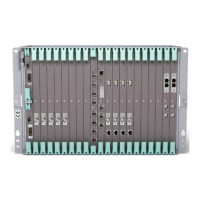Basic Node
Network Element
Assigned synchronization path
Unassigned synchronization path
9531
Figure 50 Master-slave synchronized network
In this mode MINI-LINK TN will use the Node Clock on all the protocol layers
generated in the node.
The Network Synchronized mode includes the following functions:
3.11.2 SDH Equipment Clock
The SEC function maintains an equipment clock with network reference clock
selection, clock generation, filtering and redundancy. As illustrated in Figure 51
on page 62 a list of interfaces can be selected and prioritized as candidates
for synchronization input to the SEC. All E1 and STM-1 interfaces, or when
protected their 1+1 E1 SNCP or MSP 1+1 group, are available for nomination.
It is also possible to use one of the E1 ports on the NPU1 B, NPU3 and NPU3
B as an external 2048 kHz synchronization clock input interface.
The SEC will select and do automatic synchronization trail restoration based
on the priority table and the status of the inputs. In the event of failure of all
synchronization source inputs, the SEC will enter holdover mode using its own
internal clock as source. (Note: G.813 performance during trail restoration and
holdover requires at least one SXU3 B, MMU2 C, AAU or LTU 155 plug-in
unit in the subrack)
The SEC clock is distributed throughout the subrack. All terminated protocol
layers interfaces (e.g. STM-1 and E1 from AAU) can be individually configured
to follow the SEC or to do Loop Timing, that is using the recovered receive
clock (RxClock) on the outgoing link.
61
12/221 02-CSH 109 32/1-V1 Uen A 2008-03-14

